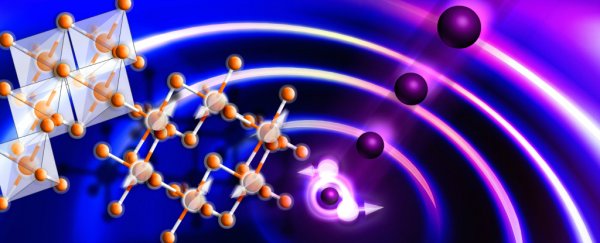Researchers have just discovered evidence of a mysterious new state of matter in a real material. The state is known as 'quantum spin liquid' and it causes electrons - one of the fundamental, indivisible building blocks of matter - to break down into smaller quasiparticles.
Scientists had first predicted the existence of this state of matter in certain magnetic materials 40 years ago, but despite multiple hints of its existence, they've never been able to detect evidence of it in nature. So it's pretty exciting that they've now caught a glimpse of quantum spin liquid, and the bizarre fermions that accompany it, in a two-dimensional, graphene-like material.
"This is a new quantum state of matter, which has been predicted but hasn't been seen before," said one of the researchers, Johannes Knolle, from the University of Cambridge in the UK.
So what is quantum spin liquid? The 'spin' doesn't actually mean anything is physically spinning in the matter, but instead describes a type of intrinsic angular momentum in quantum mechanics - in other words, it's a useful metaphor that gives you an idea of what an electron is doing. And like everything else in quantum mechanics, spin isn't a singularly defined quantity, but a distribution.
The matter itself also isn't a liquid in the traditional sense of the word, but it instead refers to the fact that the quantum spins of the electrons in the material suddenly start interacting to create a disordered state, creating all kinds of strange behaviours.
They were able to spot evidence of this happening in the material by observing one of the state of matter's most intriguing properties - electron fractionalisation - and the resulting Majorana fermions, which occur when electrons in a quantum spin state split apart. These Majorana fermions are exciting because they could be used as building blocks of quantum computers.
To be clear, the electrons aren't actually splitting down into smaller physical particles - which of course would be an even bigger deal (that would mean brand new particles!). What's happening instead is the new state of matter is breaking electrons down into quasiparticles. These aren't actually real particles, but are concepts used by physicists to explain and calculate the strange behaviour of particles.
And the quantum spin liquid state is definitely making electrons act weirdly - in a typical magnetic material, electrons behave like tiny bar magnets. So when the material is cooled to a low enough temperature, these magnet-like electrons order themselves over long ranges, so that all the north magnetic poles point in the same direction.
But when the electrons' spins start interacting and they enter quantum spin liquid state, even if a magnetic material is cooled to absolute zero, the electrons don't align, but instead form an entangled soup caused by quantum fluctuations.
"Until recently, we didn't even know what the experimental fingerprints of a quantum spin liquid would look like," said one of the researchers, Dmitry Kovrizhin. "One thing we've done in previous work is to ask, if I were performing experiments on a possible quantum spin liquid, what would I observe?"
To figure out what was going on, the researchers worked alongside a team from Oak Ridge National Laboratory in Tennessee and used neutron scattering techniques to look for evidence of electron fractionalisation in alpha-ruthenium chloride - a material that's structurally similar to graphene.
This also allowed them to measure the signatures of Majorana fermions for the first time by illuminating the material with neutrons, and then observing the pattern of ripples that the neutrons produced when scattered from the sample.
These patterns were exactly what they'd expect to see based on the main theoretical model of quantum spin liquid, confirming for the first time that they'd seen evidence of it happening in a material.
"This is a new addition to a short list of known quantum states of matter," said Knolle.
"It's an important step for our understanding of quantum matter," added Kovrizhin. "It's fun to have another new quantum state that we've never seen before - it presents us with new possibilities to try new things."
Some of those new things involve quantum computers - which would be exponentially faster than regular computers - so even though all of this sounds pretty big-picture, the research could actually have some really exciting potential applications.
The results have been published in Nature Materials.
